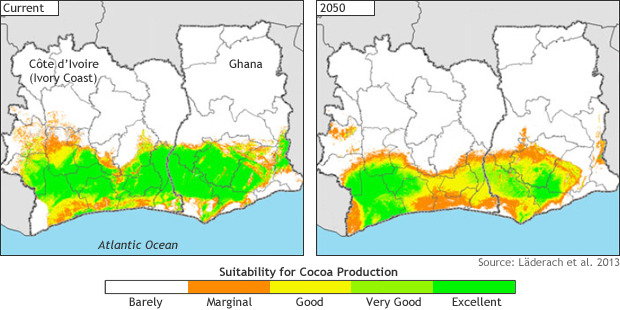Global Warming's Next Victim: Chocolate
Researchers reported this week that cacao plants are on the decline thanks to dryer weather and warming temperatures worldwide. To battle the oncoming nightmare of a world without chocolate, researchers and scientists at UC California and UC Berkeley teamed up with the Mars company and IGI. Together, the've begun to modify the genes of cacao crops to allow them to survive this planet's changing climate.
Head of the program to save chocolate for future generations of humans on this earth is Dr. Myeong-Je Cho, part of the Innovative Geonomics Institute. Cho works with Brian Staskawicz, Professor of Plant and Microbial Biology at UC Berkeley. Staskawicz is also scientific director of IGI's agricultural genomics program.
"We're developing CRISPR editing technologies to alter the DNA in cacao plants to become more resistant to both viral and fungal diseases," said Staskawicz. "Cacao can be afflicted by several devastating conditions" A release on IGI suggests that the future of crops like cacao include a wide variety of new and/or emerging threats, "from climate change to plant pathogens."
Climate Change Cacao Research
A report from NOAA showed that in the next 30 years, the amount of land mass that'll be suitable to grow cacao will be reduced significantly. Researchers lead by one P. Läderach of the International Center for Tropical Agriculture (CIAT) Managua, Nicaragua showed the devastating effects of global warming on crops of cacao in the recent past on into the future.
"Based on the current distribution of cocoa growing areas and climate change predictions from 19 Global Circulation Models, we predict changes in relative climatic suitability for cocoa for 2050 using an adapted MAXENT model," said the report. In two countries where cacao production is most important, Côte d'Ivoire and Ghana, suitable land mass for cacao cultivation is shrinking drastically.

Above you'll see two maps, one from around 2011, another for the future: The year 2050. The maps show suitability for cacao production over the course of the next couple of decades. The altitude suitable for cultivating cacao shrink, rising from 350–800 feet (100–250 meters) to 1,500–1,600 feet (450–500 meters) above sea level. Of the 294 locations examined in the study, 89.5% were likely to have significantly lowered suitability for cacao production by 2050.
Fighting Back
The team at IGI, working with UC Berkeley and UC San Francisco, are working on saving the whole world from a chocolate-less existence. They're tapping in to DNA engineering tech to make cacao plans a bit more robust than they are today.
To do this, this crew are working with the CRISPR-Cas9 genome editing system co-developed by executive director Jennifer Doudna. This tool can be used to make new combos in plant DNA, removing, adding, and changing as such. Below you'll find a video with Jennifer Doudna speaking about how CRISPR-Cas9 works to re-arrange DNA for the betterment of our shared future. Cross your fingers for more hardcore chocolate in the near future!
Learn more about the cacao research mentioned in this article with the following study: Läderach, P., Martinez-Valle, A., Schroth, G., Castro, N. (2013). Predicting the future climatic suitability for cocoa farming of the world's leading producer countries, Ghana and Côte d'Ivoire. Climatic Change, 119, 841–854.
